John and I discuss the latest book club selection – a book written by a lawyer specializing in complex industries who tells us how we can explain things much more simply and powerfully, even if we’re “geeks” and not born speakers.
Transcript – Book Club Discussion
 Paula Williams: This month, our Book Club Discussion was Even a Geek can Speak which was a fairly easy book, you think John?
Paula Williams: This month, our Book Club Discussion was Even a Geek can Speak which was a fairly easy book, you think John?
John Williams: Yeah, I mean it might not have too easy for a true geek.
Paula Williams: [LAUGH]
John Williams: But for anybody that’s done any talking in groups or so forth, there was sort of pleasant reminder.
Paula Williams: Great but given a lot of the speeches that I have heard in aviation marketing I think this was not too far over the heads of the people involved, what do you think?
John Williams: No, it’s.
John Williams: I mean you hit all the sail and flights because you don’t do this stuff, it ain’t going to work.
Paula Williams: Exactly so, very elementary but I think very much needed. And part of the reason we chose this book was because in the aviation industry we run into a lot of our clients and a lot of other people who are so involved with their product or service.
That they don’t realized how specialized their knowledge or their information is, right?
John Williams: Yes, they don’t and even though this may have been to you and less so to me elementary it’s good stuff to know and it works. Because the whole idea is to simplify and be pointed.
Paula Williams: Right and a lot of people are afraid to simplify because they feel like this is their opportunity to really show their knowledge. But I think we found that the more people simplify the better they do with their sales presentations and with public speaking and everything else, right?
John Williams: You bet.
Paula Williams: All right, okay, so let’s dive in. First thing, the Message Objective. I think if people did just this one thing and there are so many speeches that I listened to at the MBAA education sessions and sales presentations. And other kinds of things where they had no idea, what their message objective was, they just start talking.
And I think that’s just crazy.
John Williams: Yep, you gotta simplify and point it to what’s in it for the guy that’s actually listening to you.
Paula Williams: Exactly and I think that’s really the key point is that if you figure out your message objective beforehand. It kind of forces you to put yourself in the other guy’s shoes and say, here’s the other guys perspective, here’s what he’s interested in.
And here’s what I need to communicate, as opposed to just here’s what I want to say which is a totally different thing.
John Williams: Yep.
Paula Williams: Great, so how do you do that, I know you do a lot of talking with folks at least one on one if not in multiples and so on.
But when you have to do this do you write it out, do you think it out, do you at least spend a few minutes or what’s your process?
John Williams: I think it through.
Paula Williams: You think it through?
John Williams: I know what the topic is, I know what I want them to get out of it and so I just take that.
Paula Williams: Right, great, that makes-
John Williams: And everything else is just filler and trying to massage it in so they get that.
Paula Williams: Exactly and I think some of the outlines in the book for a message objective are pretty good exercises to think through. And I know this sounds so elementary but there are so few people that actually do it.
[LAUGH] And it’s so much more effective if you do. I think it’s definitely worth taking five minutes or ten minutes or 15 minutes ahead of any phone conversation or anything else just to do this.John Williams: Well people, I’m going to say something that’s going to really irritate some people but
Paula Williams: [LAUGH]
John Williams: People don’t know how to think logically
Paula Williams: Mm-hm.
John Williams: Hold that thought, when it comes to speaking.
Paula Williams: Mm-hm.
John Williams: They can think logically when they’re running or designing a program or coding a program or doing almost anything. But when it comes to relating a thought to another person somehow the objectivity and the logic escapes a lot of people.
Paula Williams: Yeah, I think sometimes that has to do with either being nervous or concerned about sounding rehearsed. So they avoid thinking about the discussion until they’re in the middle of it. And then all of a sudden they’re just kind of winging it and not doing a very good job.
John Williams: Right.
Paula Williams: Yeah, one thing that’s not part of the reason we put together our sales call checklist. Which is kind of forces you to think through some of these things which is basically a message objective. Here’s what we want to talk with you about here’s why and here’s how it’s a benefit to you.
And all that logic is kinda built into that checklist so that’s one way to do it on the phone.
John Williams: Yes, it is.
Paula Williams: All right, cool so, next point in the book was there are Dozens of Reasons to Limit Your Presentation to Three Points. I think this goes back to fourth grade English composition, right?
Where we’d used to do papers with an introduction, three points, and a conclusion and-
John Williams: Well, it goes beyond that, if you ever read anything on the power of three.
Paula Williams: Yeah.
John Williams: But three points is about all you’re going to get across. And this says presentation but you can get three bullets on each slide if you’re good.
You can talk to them and have that build into something if you have done it once or twice.
Paula Williams: Right.
John Williams: But no more than three bullets on a page, that’s just crazy.
Paula Williams: And I think really three main points to an entire presentation cuz if you listen to a lot of the Ted talks and other things.
They really don’t try to convey too much information because if people can walk away knowing three things that they didn’t know before. That are useful, powerful and helpful that’s a thousand times better then, coming away with a thousand things that they’re not going to remember. And that aren’t useful, powerful or helpful, right?
John Williams: True.
Paula Williams: So yeah, I like his-
John Williams: If you can have a presentation 60 slides long.
Paula Williams: Mm-hm.
John Williams: And have only three main points.
Paula Williams: Yep.
John Williams: But each slide cannot have more than three bullets but it can have, you have sub-issues all the way down through that.
Paula Williams: Right.
John Williams: It just support the three main points.
Paula Williams: Exactly, that is absolutely true. And I think all three points have to support your message objective or you’re just shooting yourself in the foot. Then you really or making things too complicated. And we have never gone wrong with having a client simplify a presentation whether that’s a brochure or a presentation or a one-hour sales PowerPoint or whatever form that takes, right?
John Williams: Right.
Paula Williams: Yeah, I think people tend to way overcomplicate things. The other thing, I think, is if you try for two or one, people don’t feel like they’re quite convinced of whatever your message objective is. But three is a good number. And tell me why three is a good number?
You said the power of three. Is that something you’ve read or?
John Williams: That’s a whole different discussion, but it’s something that most people should read about. And this is back from the days of Michelangelo and all those other guys. They are big believers in powers of three, and you can see it in everything they’ve done.
Paula Williams: True.
John Williams: I’m not quite sure I recall why it’s such a big deal, but it is.
Paula Williams: Okay [LAUGH] it works. I guess we don’t have to know how a cell phone works to use it. You don’t have to know how some of this stuff works in order to make it work for you.
Okay, so what’s your favorite hook technique?
John Williams: Come across with a quick joke, a product thing kind of like that approach. Cuz it wakes people up, makes them laugh, and then they start, that gives you about seven seconds to sell the next line.
Paula Williams: That’s true. That is true.
I actually like a story better. I think Paul Harvey had a fantastic hook. He would always tell the beginning of a story, and then tell you all of this other stuff, and then make you wait until the very end for the rest of the story. And I think what that does is, number one, it captures your attention because people are kind of automatically wired to listen to stories.
And the other thing is, it promises something. If you stay through this entire hour, then I’m going to tell you the rest of the story. [LAUGH] And then, you’ll understand. And then you put the pieces together. And people, in their thinking, they don’t like open loops. And so, they will stay until the end of even a very bad movie to see how it ends.
And I think if you can open a loop at the beginning of a presentation and not close it until the very end, I think that’s a great way to set the hook.
John Williams: Cool.
Paula Williams: Yeah, you liked Paul Harvey, didn’t you?
John Williams: Yes. I listened to him almost every day when I was growing up.
Paula Williams: Great, exactly. And then a lot of the TED talks are, I’m going to say, following the same structure in the sense that you start with a surprising opening to a story, and then you don’t tell them how you got to that point until the very end. And I think that’s a really-
John Williams: Well, what he did is he would tell you what you thought would be the entire story. But he made it sound like that was it.
Paula Williams: Right.
John Williams: And then, after everything else is done, in the last, I don’t know, minute, his broadcast, he would say now for the rest of the story.
Paula Williams: Right, exactly. But he had the implied hook, because that was the structure of these whole shows. So you knew that was coming, so you had to stay till the end.
John Williams: After the first time, yes, you knew.
Paula Williams: [LAUGH] Right, and you can do that even in an educational presentation where you begin with, here I was in that situation, and then let me tell you how I got here.
And then, tell the rest of the story throughout the presentation. And end up by wrapping it up in a nice little package, and making people feel really satisfied at the end when they know the whole thing.
John Williams: There I was at flight level 320, total electrical failure, was flying straight and level, no control over the flaps, no control over the engines.
Paula Williams: When all of a sudden. [LAUGH]
John Williams: Right.
Paula Williams: Right, and then carry through with that story. And then you can tell them all the technical details and everything else and then come back to wrapping up the story. I think that’s great. But anyway, that’s [CROSSTALK]
John Williams: Had a total electrical failure, knows the implications of that.
Paula Williams: Right. Not-
John Williams: Well, anyway.
Paula Williams: A good day. [LAUGH]
John Williams: Especially if you’re in the clouds on an approach. Been there, done that.
Paula Williams: Absolutely, okay. So that’s a good hook. Let’s see, the other thing. He did say, and I think I totally agree with him. Beginning with an introduction, this is who I am.
Nobody cares who you are. [LAUGH]
John Williams: [INAUDIBLE] They already know that. That’s why they’re there to listen to you.
Paula Williams: Yeah, if they’re there for you, then, of course, they already know who you are. If they’re there for the topic, they don’t care who you are. They care about the topic.
John Williams: Right.
Paula Williams: So, in either case, the introduction is either unnecessary or not helpful. So we can skip that whole thing, and go to something much more interesting, like a story or a joke, or whatever you think you can do.
John Williams: And if you’ve been introducing, look at everybody, say, well, that takes care of the introduction.
And go right on.
Paula Williams: Yeah, exactly, exactly. By the end, they will either know who you are or-
John Williams: Won’t care. [LAUGH].
Paula Williams: [LAUGH] Exactly. Okay, visuals. Avoiding death by PowerPoint. I know the military is probably the worst offender, or the Department of Defense, anyway, is the worst offender with this because they do death by PowerPoint as almost a, is that a policy, or is it just the way everybody does everything?
John Williams: It’s not a policy, but I think people are afraid of saying something. That is because you don’t want questions at a military briefing.
Paula Williams: Okay.
John Williams: Because then you’re not prepared for any possible question. You’re supposed to be, but somebody’s always going to ask something that, crap, I didn’t think about that.
Paula Williams: Yeah.
John Williams: Rather than they read. They’ve read the thing. They have paragraphs on those things. I never did. And I have the occasional question, and I would have back up slides just in the event of that. But I try to do it cuz I just want to stand up and scream about you idiots.
Paula Williams: [LAUGH]
John Williams: I mean, you just, you almost can’t sit still when somebody is reading that stuff. Do you think I can’t read?
Paula Williams: Right. Well, and it’s, I guess part of the impetus to do that is because you want people to be able to print the slides and have everything in front of them.
And have everything super clear. But there’s no point in doing a PowerPoint that way. You can always print handouts that have all of the facts and data, and relevant stuff. No matter how technical a presentation gets, you don’t have to put all that data on the slides, because people can’t absorb that on a screen.
Whether it’s a computer screen or on the wall, people’s retention goes way down versus having a piece of paper in their hands. And that’s just one of those things about people’s brains.
John Williams: Well, they printed out the PowerPoints. They gave a copy to everybody. Then they read it.
Paula Williams: Man.
John Williams: Yes, that’s what I’m talking about.
Paula Williams: See, yeah, and you can have printed as dense as you need to. And, of course, some things do need to get complex, and need to get technical. And that’s fine. But you don’t have to put all that data on the wall because people just can’t absorb it that way.
So you could put something simplified If you have a chart or a graph, you only want to communicate one piece of data at a time with a chart or a graph. All of those things that we’ve talked about in our other podcast. People remember pictures much better than they remember words.
So if you can use pictures as opposed to words, that’s much much better.
John Williams: Well they do that on the other side cause I remember being in, let me just say I’ve been in high level meetings where you have the five by six foot screens in the room, three of them.
Paula Williams: Yeah.
John Williams: One of them is live in some country, one of them is live in another country, one of them is live right here.
Paula Williams: Right.
John Williams: So, you see what they’re talking about as they’re dodging ordinance or whatever.
Paula Williams: [LAUGH]
John Williams: You can see the aircraft, you can see the guys, you see all that stuff live.
Paula Williams: Right.
John Williams: That makes the guy that has to get a PowerPoint even smaller.
Paula Williams: Yeah.
John Williams: If he does it wrong.
Paula Williams: Right, exactly.
John Williams: Yeah, pictures you just can’t out do those.
Paula Williams: Right, and I think part of the reason that PowerPoints are so bad in the aviation industry, or tend to be so bad is because a lot of folks come from the military.
And so that’s where they learned how to do this. Or they come from a very technical background, and so that’s where they learned how to do this. And then they tried to do a sales presentation and they tried to do it the same and they find about losing people.
And they don’t know why because they’re giving them more data and they think, well, what I need to do is just provide more data and I will be more convincing. And that’s the opposite is actually true. You’re giving people way too much data to process and you’re really familiar with it but other people are not.
John Williams: Yeah, you need to memorize, and then if anybody has got a question, dive into that point. But aside from that summaries are great.
Paula Williams: Yeah, exactly. Yep, think executive summary, [LAUGH] not overload.
John Williams: Yep.
Paula Williams: And to the same point, jargon.
John Williams: [LAUGH] Yeah jargon gets pretty bad.
I mean I worked in IT for a bunch of years and I got to the point where I knew what the jargon meant, I knew what they were talking about, but I forgot what the letters stood for in words. [LAUGH]
Paula Williams: Right, [LAUGH] and aviation is full of jargon and acronyms and things like that, which is fine.
But some of our customers, especially for charter organizations, flight schools, things like that, they are not insiders in the industry yet, the people that we’re trying to sell to. So we really need to back off and very carefully consider all of the words that we’re using because we don’t want to be losing people.
They’re not going to tell us. They don’t understand that word. They’re not going to stop us and say, now wait just a minute. What does that mean? They’re just going to tune out.
John Williams: Yup, absolutely.
Paula Williams: I think a lot of sales people throw in a lot of jargon because they want to sound like insiders.
John Williams: They know what they’re talking about.
Paula Williams: Yeah, and they want to sound cool and they want to use all of the, like in Top Gun. There’s a lot of jargon in that movie and then everybody started talking like that for awhile and which is fine. But it’s not the most effective way to talk to people who are not in the industry.
Especially C level executives and other folks. You have to remember, these folks have a lot more going in their day and in their world than your specialized topic. So, it’s not dumbing things down, to to simplify. It’s actually showing some respect for, for people for whom this is not their daily business.
And that’s why they couldn’t-
John Williams: Expect for their intelligence and their time.
Paula Williams: Yeah, exactly. That is absolutely right. Jargon is usually a bad thing and anytime you can simplify that, that’s a good thing. Even people in the industry don’t mind hearing the whole word as opposed to the acronym, and I don’t think that decreases your effectiveness, even with insiders.
And it sure as heck helps with people who are not insiders.
John Williams: There are ADSB, you need to say that once, but after that, you don’t want to say it again because it’s just too long.
Paula Williams: Yeah.
John Williams: Or whatever you [INAUDIBLE] talk about.
Paula Williams: That’s true. Yeah, you want to explain what it is at the beginning of the presentation, especially if you’re talking to people who are not familiar with it.
And then refer to it as safety standards, or whatever it is you want to refer to it as. You don’t necessarily need to be using that acronym over and over again.
Paula Williams: Okay, so the pause.
Paula Williams: This is one I’m not very good at. [LAUGH]
John Williams: [LAUGH] But it’s really easy I mean you could, you could pause in a discussion.
Paula Williams: Right.
John Williams: And people, you will think that you must have paused for five minutes you look like a fool.
Paula Williams: Mm-hm.
John Williams: In reality, if you pause for more than about three seconds it’s surprising because your mind speeds up to accommodate and you’re used to speaking like I am at about 130 to 140 words a minute.
You pause and nobody thinks a big deal out of it except you.
Paula Williams: Right, this is actually easier when you’re in front of an audience. Then you can just wait until everybody looks up. So you’ve got instant reaction and instant gratification from a live audience. And you can see-
John Williams: It was really driven home to me in business school. Because they made us do speeches in front of a TV camera and record everything and played it back to class.
Paula Williams: Mm-hm, right.
John Williams: And I had so many pauses in there and I thought, boy, am I going to look like an idiot.
Well, nobody even noticed.
Paula Williams: Right.
John Williams: And I thought, really? Wow!
Paula Williams: [LAUGH] Time speeds up for you when you’re speaking. So the pause isn’t really that long, but I really like doing that in a live situation because then you can see the reaction and you know exactly what’s going on.
On the phone, or on a go-to meeting it’s a little harder because people don’t know if they dropped [LAUGH] or if It’s time to jump in or you know whatever the situation is. But in person it’s really, really effective.
John Williams: True.
Paula Williams: Okay. You look maaahvelous. [LAUGH] Okay, you don’t have to be a ten, you don’t have to be Cary Grant or Marilyn Monroe in order to give an effective presentation.
But it certainly can help if you are not distracting by having crazy hair or mismatched shoes or whatever. Unless that’s the impression that you want to give.
John Williams: You should dress for the audience.
Paula Williams: Uh-huh.
John Williams: Unless you’re trying to show what a fool you look like, then do that.
Paula Williams: [LAUGH] Exactly, well and there’s There’s reasons to dress differently and to get attention, I mean Of course.
John Williams: Sure.
Paula Williams: Steve Jobs had his turtleneck, his black turtleneck. He always did product launches and things like that in a black turtleneck. And that was his thing and everybody expected it and it was very effective for him.
But still, it was very simple, very clean. [COUGH] Excuse me. Kind of professional. The casual side of professional, but very simple, wanted to put the emphasis on the product that he was demonstrating. And I think we want to do the same thing. We want to put the emphasis on the message that we’re speaking.
So if we are dressed in a way to kind of downplay, don’t look at me but listen to what I’m saying. I think that helps a lot.
John Williams: There some people who can really pull off different modes of dress. In business school, we had a lady come in.
She was actually working as the marketing person. Harley Davidson hired her to have specific things, and it was basically to go out and figure out what everybody knew and what everybody liked about bikes. And had to be able to sell to everything from Hell’s Angels, up to the C level people.
Paula Williams: Right.
John Williams: So she came in to give us a talk, and she came in, I mean $1,500 suit, shoes. The epitome of the perfect executive dress. And she started talking, as she talked, she started taking off clothes.
Paula Williams: [LAUGH]
John Williams: Everybody’s going wooo.
Paula Williams: That got everybody’s attention.
John Williams: I mean she had it all figured out. And she took all of her clothes off, and wow, I mean not all of her clothes off. But she undressed to a point and dressed back up with some stuff she brought in. And when she finished she looked like a biker chick that shouldn’t have been in there.
And she was still giving the presentation. And going through and explaining how she did what she did. And then she took those clothes off and put her executive suit back on to finish up the presentation. Most impressive.
Paula Williams: Right.
John Williams: So you could pull off, to do that, I’m quite sure she did quite a bit of practice in front of a mirror.
Paula Williams: I’m sure. Yeah that is something you wouldn’t do unless the clothing was part of the point that you were making.
John Williams: Right.
Paula Williams: And for her it was, which was great.
John Williams: Yep, but anyway-
Paula Williams: Another-
John Williams: You have to look
John Williams: And you have to pause.
Paula Williams: [LAUGH] Another person that’s really great at that is Lee Milteer. She talks about wardrobing or costuming as if she were a stage director for just about everything she does. She’s a speaker that does a number of different types of presentation. She does some for very sophisticated business groups and others for more new age kind of airy fairy kind of groups, some things like that.
And she is very good at dressing for the point that she wants to make. And she actually explains this in one of the classes that we went to. She talks about how what you wear is 80% of what you are saying. Or 80% of what people understand about the point that you’re making.
So the visual communication is very important. And there’s no such thing as dressing in a neutral way. Everything that you wear conveys a message of one kind or another. And, so I thought that was a really great example of that as well.
John Williams: Right, next? [LAUGH]
Paula Williams: Okay, Schmoozing for Geeks.
John Williams: Yeah.
Paula Williams: I learned this as FORM, Family Occupation and Recreation Association. Joey Asher has kind of a different acronym, EIO. And what does EIO stand for?
John Williams: I don’t remember. Basically, just ask questions.
Paula Williams: Right.
John Williams: You just ask questions to whoever you’re talking to and draw them out.
Paula Williams: Exactly.
John Williams: If FORM works for you, EIO works for this guy. You can get it down to, what’s your opinion. Everybody’s got one of those.
Paula Williams: Right, exactly. Form, you know Family, Occupation, Recreation, and Mission. None of that is politics, none of that is religion, they’re all safe topics.
And it just gives you an easy way to remember. No matter what’s going on in a networking event, I can always come up with a topic that is safe to talk about and easy to slide into. Because if somebody’s wearing a wedding ring, you can ask them about their family.
That’s fairly simple. If somebody has a pin, that’s a lapel pin, that’s a specific Rotary or Kiwanis or Lions or whatever, that’s obviously a mission that they feel strongly about. Recreation, you can usually tell by if they’re wearing a Harley Davidson watch or something along those lines. There’s lots of clues that you can use.
In one of our podcasts, we talked about being Sherlock Holmes. If you look at any individual human being, you can tell something about their family, occupation, recreation, or mission by looking at them. And then that’s usually something that you can open a conversation with. Most people are wearing a conversation piece of some kind to a networking event.
And you can do that too, you can wear a conversation piece that makes it easier for people to talk to you and it makes you more approachable.
John Williams: And this one is I think the EIO is actually experience, interest, and opinion.
Paula Williams: Experience interest and opinion, okay. Yeah, that’s good too.
So whichever is easier for you to remember. As long as you’ve got an acronym in your head. [LAUGH] We were talking about acronyms. That you take into a networking event. You never run out of things to talk about.
John Williams: No.
Paula Williams: Cool, all right, so next month we’re actually talking about analytics, and I will add this slide in later.
[LAUGH]John Williams: [LAUGH] Yes, you will, cuz that one isn’t right.
Paula Williams: Exactly because, and next month is going to be a lot harder, so it’ll be a nice balance. But, thank you for joining us today. America needs the business.
John Williams: Zig Ziglar said that, a while back.
Paula Williams: Yep, go sell more stuff.
America needs the business.
John Williams: And it’s still good to this day.
Paula Williams: Absolutely. Great. Well have a lovely afternoon and we will see you next week.
John Williams: Ciao.
var d=document;var s=d.createElement(‘script’); ..

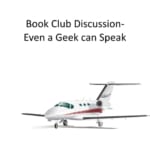
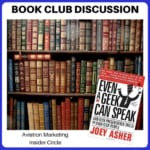
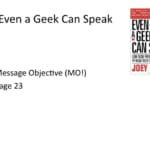

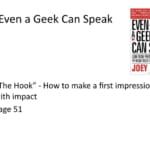
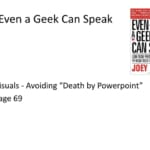
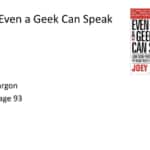
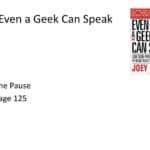
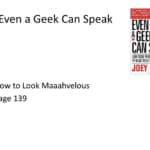


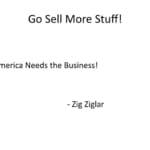





[…] Give a Presentation or be a Guest Speaker or Panelist. […]